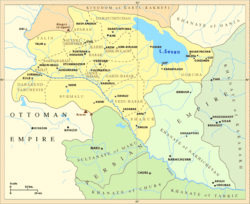Nakhichevan Khanate
| Khanate of Nakhchivan | ||||||||||
| خانات نخجوان | ||||||||||
|
Khanate |
||||||||||
|
||||||||||
|
The Nakhichevan and Yerevan khanates, c.1800.
|
||||||||||
| Capital | Nakhchivan | |||||||||
| Languages | Persian (official), | |||||||||
| Political structure | Khanate | |||||||||
| History | ||||||||||
| • | Established | 1747 | ||||||||
| • | Disestablished | 1828 | ||||||||
|
||||||||||
The Nakhchivan Khanate (Persian: خانات نخجوان — Khānāt-e Nakhchevān) was a khanate that was established in Safavid Persia in 1747. The territory of the khanate corresponded to most of the present-day Nakhchivan Autonomous Republic and Vayots Dzor Province of present-day Armenia. It was named after its chief settlement, the town of Nakhchivan.
Until the demise of the Safavid Empire, Nakhchivan remained as an administrative jurisdiction of the Yerevan Province (also known as Chokhur-e Sa'd). Shortly after the recapture of Yerevan in 1604 during the Ottoman-Safavid War of 1603-1618, then incumbent king (shah) Abbas I (r. 1588-1620) appointed as its new governor Cheragh Sultan Ustajlu, who, after his brief tenure, was succeeded by Maqsud Sultan. Maqsud Sultan was a military commander who hailed from the Kangarlu branch of the Ustajlu tribe, the latter being one of the original Qizilbash tribes that had supplied power to the Safavids since its earliest days. The Kangarlu were described by J. M. Jouannin as “a small tribe established in Persian Armenia on the shores of the Aras". Later that year, as Ottoman forces threatened the area during the same war, Shah Abbas ordered Maqsud Sultan to evacuate the entire population of the Nakhchivan region (including the Armenians of Jolfa, who, in the following year, were transplanted to Isfahan) to Qaraja Dag (Arasbaran) and Dezmar. Persian rule was interrupted by Ottoman occupation between 1635-1636 and 1722-1736. It officially became a full functioning khanate during the Afsharid Dynasty. Initially the territory of Nakhchivan was part of the Erivan Khanate, but later came to be ruled by a separate khan.
...
Wikipedia

